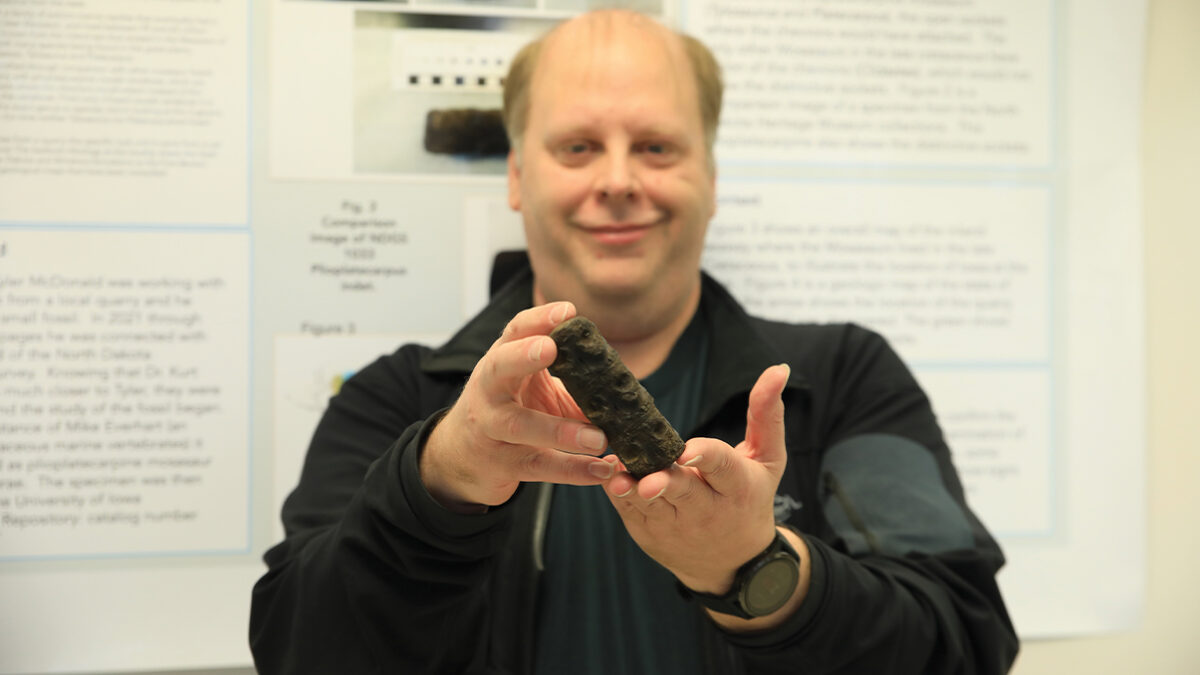The First Mosasaur Fossil Found in Iowa


When a local community member, Tyler McDonald, discovered a fossil in a load of gravel in 2015, he was unsure what to do with it or who to ask. After holding onto it for a few years and reaching out to a variety of people, he was eventually connected with Dr. Kurt Spearing, an associate professor in the Natural & Mathematical Sciences Department.
Spearing has been with Morningside for 14 years and teaches courses in human anatomy, vertebrate paleontology, and comparative vertebrate anatomy. His doctoral research was focused on saber tooth cat fossils in the United States, and has continued his work both in the field and in the lab.
“I have done some work with dinosaurs, but a lot of it has been with smaller invertebrate organisms,” Spearing said. “In my Ph.D., I worked with fossil cats like saber tooth cats. Believe it or not, there actually used to be cheetahs right here in the center of North America.”
Most recently, Spearing was approached about a fossil found in a gravel pit in Northwest Iowa in 2015. In 2021, Dr. Clint Boyd of the North Dakota Geological Survey, who is a close friend of Dr. Spearing, reached out to Spearing about this fossil.
“Tyler McDonald is a roofer, so he works with gravel for a lot of his large scale projects, and in one of those loads of gravel, he found something that looked like a fossil,” Spearing said. “Through a series of social media pages, Tyler was connected with a close friend of mine in North Dakota, who contacted me about this fossil.”
While Spearing is familiar with Mosasaur fossils from early in his career, he hadn’t come across one in Iowa. Upon further investigation it turned out this find was unique. Spearing’s investigation showed there hadn’t been a Mosasaur fossil discovered in Iowa, and when he took this discovery to the annual meeting of the Geological Society of America in Pittsburgh, Pennsylvania in October, no one disputed his claim.
“Over the course of the last couple years, I was able to do some research with it and confirm that it was what we thought it was,” Spearing said. “This fall, I presented at an international conference where the title of my talk was, ‘The First Mosasaur Fossil Found in Iowa.’”
The fossil is a set of three caudal vertebrae from a Plioplatecarpine Mosasaur. This fossil can be found around the Midwest because this region of the country used to be underwater and Sioux City would’ve been coastal property in that time, Spearing said.
“A Mosasaur is a marine reptile, kind of like a Komodo Dragon or a Monitor Lizard, but picture one of those that is 20-to-30 feet long with flippers instead of legs,” Spearing said. “These guys were probably the top predator of their time, and they lived from roughly 100 million years ago to about 66 million years ago. During the time when the dinosaurs were around in the Mesozoic, most of the Great Plains was actually underwater.”
Spearing has done research with students over the years as well. Recently, Spearing has worked with a student on a small fossil dog from North Dakota. That research will be published soon.
Spearing has done research with students over the years as well. Recently, Spearing and worked with a student (Riley Farrington ‘20) on a small fossil dog from North Dakota. That research will be published soon. Most of Spearing’s research work with students has been in the anatomical field, but a handful of students have shown interest in extinct animals and fossils.
“Some colleagues of mine and I found a fossil where the ear bones are actually intact in this fossil cat, which is almost unheard of,” Spearing shared. “Ear bones are tiny, tiny things, and they usually disintegrate or get lost. I had a student working with me to compare the fossil ear bones to a cat’s ear bones today.”
Spearing has also taken students to the field to search for fossils and research fossils outside of the Walker Science Center. Outside of teaching class and working on research with his students, Spearing occassionally has community members visit him with questions about a fossil or unusual rock they have once a year or so.
“A few months ago, someone from the community brought in what was essentially part of a mammoth molar that had been worn away so badly it didn’t really look like bone,” Spearing said. “The guy who found it knew it was something unusual and he wanted to bring it in and have someone look at it.”
Spearing and his students are usually willing to take a look at anything unique that the community brings to their attention. Sometimes, like in the case of the molar or the Mosasaur, something is unique enough that it is fairly easy to identify, but there are cases where Spearing and his students have to conduct additional research to identify the fossil.
As for what’s next in the field of research, Spearing is focusing on finishing up his research on the Mosasaur and continuing his field work in North Dakota. One day, he would love to excavate a saber tooth skeleton.
“My dissertation research dealt with fossil cats, including the saber tooth, so it would be really interesting to excavate or discover and excavate a saber tooth skeleton,” Spearing said. “There have not been very many found in a one state or so radius of here. They should be there, there just haven’t been that many found and that would be really interesting.”
Spearing encourages people who have fossils or unique looking rocks that they want to learn more about to reach out to him, and students who are interested in fossil research can also contact him to get more information.